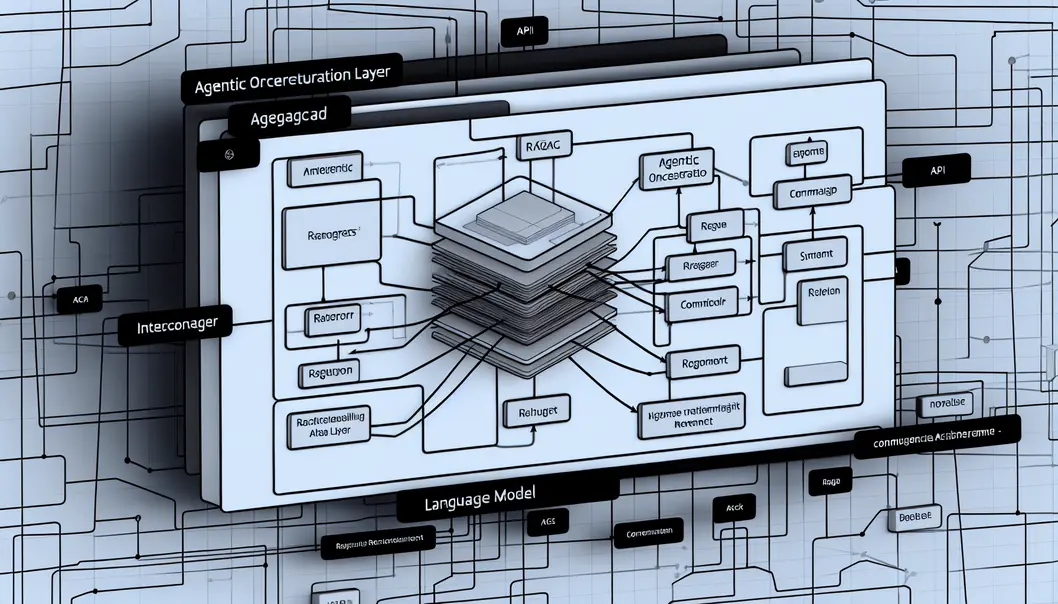Agentic RAG represents a pioneering advancement in AI technology, integrating autonomous AI agents into the Retrieval-Augmented Generation (RAG) pipeline. By combining cutting-edge frameworks like AutoGPT and LangChain, it transforms traditional RAG models, enhancing flexibility and fluidity. As we delve deeper, we will explore the core architecture and the real-world impact of Agentic RAG, revealing how it elevates complex query-handling and decision-making capabilities.
The Role of Agentic Orchestration in Modern AI

1. Laying the Foundation: Understanding Agentic Orchestration in Agentic RAG
Agentic orchestration within the Agentic RAG framework represents a cutting-edge approach to managing complex workflows by harmonizing AI agents, RPA robots, and human workers under a unified system. This orchestration layer fundamentally serves as the backbone of the solution, seamlessly integrating a mosaic of capabilities to ensure optimal task distribution and execution. The key element here is the central controller, which acts as a maestro, directing when and how each AI agent performs its role without interference. This coordination is critical in real-time data processing environments where adaptability and scalability are paramount. By distributing tasks based on the inherent strengths of AI agents and RPA, workflows are streamlined for efficiency, making Agentic RAG especially adept at handling dynamic decision-making processes. Furthermore, the shared context among agents facilitates informed task allocation, ensuring that the workflow can not only keep pace with change but also thrive amid complexity. For more insights into practical applications, explore our article on Retrieval-Augmented Generation. Thus, Agentic orchestration stands as a pivotal component in enhancing enterprise operations through superior task management and intelligence.
2. Integrating Intelligence: Essential Elements of the Agentic Orchestration Layer
The agentic orchestration layer of an Agentic RAG solution is a sophisticated framework designed to enhance AI-driven workflows by merging autonomous agents and automated tools. At its core is the Agent Core, the execution engine that harmonizes all workflow components, ensuring tasks are performed swiftly. Complementing this is the Reasoning Module, which uses AI models to strategize workflows, breaking down tasks, and selecting suitable tools for efficient outcomes. Memory is crucial to this system, with the Memory Module maintaining both short-term and long-term contextual knowledge to support intelligent agent actions.
The framework thrives on its extensive Toolset, comprising various integrations and APIs, allowing the agents to interface seamlessly with external systems for tasks ranging from data retrieval to system updates. Overarching this is the Orchestration Layer, a dynamic project manager directing task sequences and monitoring their efficiency. Enhancing this system further is a Multi-Agent System that decentralizes tasks to specialized agents, each adept in distinct operational areas. Last, but not least, a system of Shared Context and Memory ensures fluid information flow among agents, fostering effective collaboration and task execution.
For insights into how these components enhance AI systems, explore more about model context protocols.
3. Emerging Frontiers and Strategic Applications of the Agentic Orchestration Layer
The agentic orchestration layer plays a pivotal role in managing and executing complex tasks in AI systems by enhancing decision-making autonomy and adaptability. Its potential future scope is deeply rooted in its capabilities for autonomous decision-making and the ability to adapt to novel scenarios, thus making workflows more efficient and responsive to real-time data. Furthermore, as multi-agent systems develop, they are set to cultivate emergent collective intelligence through specialized agent ecosystems, allowing for more seamless collaboration and problem-solving.
Another exciting aspect of the agentic orchestration layer is its synergy with emerging technologies such as low-code and no-code platforms. This integration not only democratizes AI use but also heightens ROI significantly compared to non-orchestrated AI, fostering greater accessibility across various industries. Applications range from dynamic lead management and AI-powered customer support in sales, to predictive maintenance and autonomous trading systems in manufacturing and finance. In addition, real-time threat detection in cybersecurity showcases the layer’s adaptability to evolving threats.
Successful implementation, however, depends on overcoming challenges related to technical infrastructure, ethical guidelines, and scalability. As discussed here, maintaining a balance between technological sophistication and ethical transparency is crucial for future advancements.
Final thoughts
Agentic RAG stands at the forefront of AI innovation, with its seamless integration of autonomous agents redefining how complex queries and decision-making processes are managed. By enhancing flexibility, intelligence, and adaptability, Agentic RAG offers unparalleled potential across various industries. As AI continues to evolve, embracing these advancements will be crucial for those looking to maintain a competitive edge.
Ready to elevate your business with cutting-edge automation? Contact AI Automation Pro Agency today and let our expert team guide you to streamlined success with n8n and AI-driven solutions!
About us
AI Automation Pro Agency is a forward-thinking consulting firm specializing in n8n workflow automation and AI-driven solutions. Our team of experts is dedicated to empowering businesses by streamlining processes, reducing operational inefficiencies, and accelerating digital transformation. By leveraging the flexibility of the open-source n8n platform alongside advanced AI technologies, we deliver tailored strategies that drive innovation and unlock new growth opportunities. Whether you’re looking to automate routine tasks or integrate complex systems, AI Automation Pro Agency provides the expert guidance you need to stay ahead in today’s rapidly evolving digital landscape.



